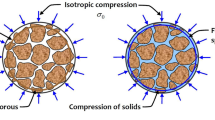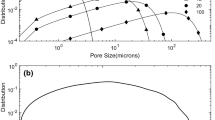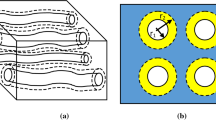Abstract
The stress dependency of the porosity and permeability of porous rocks is described theoretically by representing the preferential flow paths in heterogeneous porous rocks by a bundle of tortuous cylindrical elastic tubes. A Lamé-type equation is applied to relate the radial displacement of the internal wall of the cylindrical elastic tubes and the porosity to the variation of the pore fluid pressure. The variation of the permeability of porous rocks by effective stress is determined by incorporating the radial displacement of the internal wall of the cylindrical elastic tubes into the Kozeny–Carman relationship. The fully analytical solutions of the mechanistic elastic pore-shell model developed by combining the Lamé and Kozeny–Carman equations are shown to lead to very accurate correlations of the stress dependency of both the porosity and the permeability of porous rocks.











Similar content being viewed by others
Abbreviations
- A 1 and A b :
-
Pore and bulk cross-sectional areas of porous rock (m2)
- a, b, c, d and e :
-
Empirical parameters
- a′, b′, c′ and D′:
-
Empirical parameters
- A, B, C, D and F :
-
Empirical parameters
- E :
-
Young’s modulus (Pa)
- K :
-
Intrinsic permeability of porous rock (m2)
- K o :
-
Intrinsic permeability at a reference effective stress \( \sigma_{\text{o}} \) (m2)
- L 1 and L b :
-
Length of actual tortuous flow path and bulk length of porous rock (m)
- n :
-
Number of flow paths formed in porous rock
- p :
-
Pore fluid pressure (Pa)
- p 1 and p 2 :
-
Pressures applied over the inside surface radius r1 and the outside surface radius r2 of a hollow elastic cylindrical tube (Pa)
- q :
-
Flowing fluid volumetric flow rate (m3/s)
- r 1 :
-
Average internal radius of the bundle of elastic capillary tubes (m)
- r 2 :
-
Average external radius of influence of the variation of the pressure inside the flow tube beyond which no deformation occurs (m)
- R 2 :
-
Coefficients of regression, dimensionless
- X:
-
Biot–Willis poroelastic coefficient, dimensionless
- V 1 and V b :
-
Pore volume and bulk volume of porous rock (m3)
- \( \alpha ,\beta \) :
-
Parameters
- \( \sigma \) :
-
Effective stress (Pa)
- \( \sigma_{\text{c}} \) :
-
Total confining stress (Pa)
- \( \delta_{\text{r}} \) :
-
Radial displacement at any radius r (m)
- \( \mu \) :
-
Fluid viscosity (Pa s)
- \( \upsilon \) :
-
Poisson’s ration of the reservoir rock formation, dimensionless
- \( \tau \) :
-
Tortuosity, dimensionless
- ϕ :
-
Porosity of porous formation, fraction
- ϕ o :
-
Reference porosity, fraction
References
Abdalrahman, T., Scheiner, S., Hellmich, C.: Is trabecular bone permeability governed by molecular ordering-induced fluid viscosity gain? Arguments from re-evaluation of experimental data in the framework of homogenization theory. J. Theor. Biol. 365, 433–444 (2015)
Bernabé, Y.: The effective pressure law for permeability in Chelmsfordgranite and Barre granite. Int. J. Rock Mech. Min. Sci. Geomech. Abstr. 23(3), 267–275 (1986). https://doi.org/10.1016/0148-9062(86)90972-1
Biot, M.A.: General theory of three-dimensional consolidation. J. Appl. Phys. 12(2):155–164 (1941). https://doi.org/10.1063/1.1712886
Biot, M.A., Willis, D.G.: The elastic coefficients of the theory of consolidation. J. Appl. Mech. 24, 594–601 (1957)
Byerlee, J.D., Zoback, M.D.: Permeability and effective stress. AAPG Bull. 59(1), 154–158 (1975)
Carman, P.C.: The determination of the specific surface of powder: I. J. Soc. Chem. Ind. 57, 225 (1937a)
Carman, P.C.: Fluid flow through a granular bed. Trans. Inst. Chem. Eng. Lond. 15, 150–167 (1937b)
Carman, P.C.: Flow of Gases Through Porous Media. Butterworths, London (1956)
Civan, F.: Reservoir Formation Damage-Fundamentals, Modeling, Assessment, and Mitigation, 1st edn. Gulf Pub, Butterworth-Heinemann, Houston, Woburn (2000). ISBN 0-88415-301-0
Civan, F.: Scale effect on porosity and permeability-kinetics, model, and correlation. AIChE J. 47(2), 271–287 (2001)
Civan, F.: Relating permeability to pore connectivity using a power-law flow unit equation. Petrophys. J. 43(6), 457–476 (2002)
Civan, F.: Characterization of reservoir flow units based on a power-law equation of permeability obtained from an interacting bundle of leaky tubes model. SPE-187289-MS. The 2017 SPE Annual Technical Conference and Exhibition held in San Antonio, TX, 9–11 October 2017 (2017)
Civan, F.: Porous Media Transport Phenomena. Wiley, Hoboken (2011)
Civan, F.: Stress dependency of permeability represented by an elastic cylindrical pore-shell model: Comment on Zhu et al. (Transp Porous Med (2018) 122:235–252). Transp. Porous Media 127(3), 573–585 (2019). https://doi.org/10.1007/s11242-018-1213-0
Civan, F.: Compressibility, porosity, and permeability of shales involving stress shock and loading/unloading hysteresis. Paper SPE-195676-PA, SPE Journal, Society of Petroleum Engineers (2019b, accepted)
Gangi, A.F.: Variation of whole and fractured porous rock permeability with confining pressure. Int. J. Rock Mech. Min. Sci. Geomech. Abstr. 15(5), 249–257 (1978)
Ghabezloo, S., Sulem, J., Guedon, S., Martineau, F.: Effective stress law for the permeability of a limestone. Int. J. Rock. Mech. Min. 46, 297–306 (2009)
Jaeger, J.C., Cook, N.G.W., Zimmerman, R.W.: Fundamentals of Rock Mechanics. Wiley, New York (2009)
Jones, C., Somerville, J., Smart, B., Kirstetter, O., Hamilton, S., Edlmann, K.: Permeability prediction using stress sensitive petrophysical properties. Pet. Geosci. 7(2), 211–219 (2001)
Kozeny, J.: Uber Kapillare Leitung des Wasser im Boden. Sitzungsbericht der Akademie der Wissenschaften, Wien 136, 271–306 (1927)
Lamé, G.: Leçons sur la Théorie Mathématique de l’Élasticité des Corps Solides. Bachelier, Paris (1852)
Morris, J.P., Lomov, I.N., Glenn, L.A.: A constitutive model for stress-induced permeability and porosity evolution of Berea sandstone. J. Geophys. Res. 108(B10), 2485 (2003). https://doi.org/10.1029/2001JB000463
Morrow, C.A., Shi, L.Q., Byerlee, J.D.: Permeability of fault gouge under confining pressure and shear stress. J. Geophys. Res. Solid Earth 89, 3193–3200 (1984)
Nelson, R.: Fracture permeability in porous reservoirs: experimental and field approach. Dissertation for the Doctoral Degree. Texas A&M University, Texas (1975)
Seebyrger, D.A., Nur, A.A.: Pore space model for rock permeability and bulk modulus. J. Geophys. Res. 89(B1), 527–536 (1984)
Silvano, S.: Mathematical model of the Lame’ problem for simplified elastic theory applied to controlled-clearance pressure balances. arXiv ID: arXiv:1007.0813S, fulldisplay.datasource. Cornell University (2010).
Tan, X.-H., Li, X.-P., Liu, J.-Y., Zhang, L.-H., Fan, Z.: Study of the effects of stress sensitivity on the permeability and porosity of fractal porous media. Phys. Lett. A 379, 2458–2465 (2015)
Wenlian, X., Tao, L., Min, L., Jinzhou, Z., Lingli, Z., Ling, L.: Evaluation of the stress sensitivity in tight reservoirs. Pet. Explor. Dev. 43(1), 115–123 (2016)
Yale, D.P.: Network Modeling of Flow, Storage, and Deformation in Porous Rocks. Stanford University, Stanford (1984)
Yarushina, V.M., Bercovici, D., Oristaglio, M.L.: Rock deformation models and fluid leak-off in hydraulic fracturing. Geophys. J. Int. 194, 1514–1526 (2013). https://doi.org/10.1093/gji/ggt199
Yarushina, V.M., Podladchinov, Y.Y.: (De)compaction of porous viscoelastoplastic media: model formulation. J. Geophys. Res. Solid Earth 120, 4146–4170 (2014). https://doi.org/10.1002/2014JB011258
Zimmerman, R.W.: Compressibility of Sandstones, Developments in Petroleum Science, vol. 29. Elsevier, Amsterdam (1991)
Zhu, S.Y., Du, Z.M., Li, C.L., et al.: A semi-analytical model for pressure-dependent permeability of tight sandstone reservoirs. Transp. Porous Med. 122(2), 235–252 (2018)
Zoback, M.D., Byerlee, J.D.: The effect of Microcrack Dilatancy on the Permeability of Westerly Granite. J. Geophys. Res. 80, 752–755 (1975)
Author information
Authors and Affiliations
Corresponding author
Additional information
Publisher's Note
Springer Nature remains neutral with regard to jurisdictional claims in published maps and institutional affiliations.
Appendix: Semi-analytical Formulation of Stress-Dependent Porosity and Permeability of Porous Rocks
Appendix: Semi-analytical Formulation of Stress-Dependent Porosity and Permeability of Porous Rocks
The stress dependence of porosity was approximated by the following empirical exponential decay equation by Zhu et al. (2018) and later by Civan (2019a). The linear dependence on the effective stress was expressed by a truncated Taylor series expansion and then using Eq. (10) as:
Consequently, by applying Eq. (A-1), Civan (2019a) derived the following semi-analytic equation for stress-dependent permeability:
where a′, b′, c′, and D′ are some parameters.
Here, it is shown that Eq. (A-1) can be derived also by neglecting several terms in Eq. (14) and applying Eqs. (2) and (3) as the following.
Solving Eq. (A-3) for porosity \( \phi \) yields the above given Eq. (A-1) as:
This exercise reveals that Eq. (A-1) involves a significant simplification compared to the full mechanistic model developed in this paper.
Rights and permissions
About this article
Cite this article
Civan, F. Stress-Dependent Porosity and Permeability of Porous Rocks Represented by a Mechanistic Elastic Cylindrical Pore-Shell Model. Transp Porous Med 129, 885–899 (2019). https://doi.org/10.1007/s11242-019-01311-0
Received:
Accepted:
Published:
Issue Date:
DOI: https://doi.org/10.1007/s11242-019-01311-0




